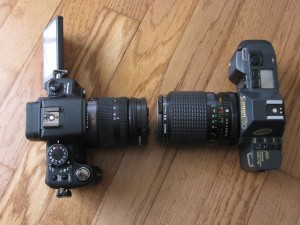For literally years now, I have been craving a more capable camera.
I’ve managed to do some amazing and artistic things with small but advanced pocket cameras like the Canon SX110IS that we relied on throughout most of 2009, but I continuously found myself pushing the edges of what small cameras were capable of – particularly once we started experimenting with light painting and long exposure photography.
But every time I’d begin to get tempted by a DSLR, I’d find myself turned off by the size and weight of the camera bodies and especially the lenses. I don’t have any interest in carting around a suitcase full of photography gear, and when it comes down to it – the absolute best camera is the one that is with you when you stumble across a great shot. I knew that anything bulky or complex would more often than not be left behind.
Every year I’d research the latest in DSLR’s, get tempted, and then talk myself out of it. The bulk (and expense!) just wasn’t worth it – particularly considering I’d only ever want to own just a lens or two. It’s not like I had a 30 year investment in legacy lenses that I cared about….

But then last year I started to hear about the upcoming promise of EVIL cameras, and the new Micro Four Thirds standard being pioneered by Panasonic and Olympus.
While Nikon and Canon DSLR’s are unquestionably excellent, they are victims of their legacy – and to maintain compatibility with their vast library of lenses they are based around the same optical design as film camera’s from decades ago. Central to every traditional DSLR is a mechanical mirror that needs to swing out of the way each shot, and a bulky glass prism that focuses the light onto the optical viewfinder that you look through. Up until just last year most DSLR’s couldn’t even offer a “live preview” on the LCD screen of the shot you were about to take (because the mirror is in the way of the sensor until you press the shutter), and even the newest DSLR’s sacrifice focusing speed while the live view modes are engaged.
EVIL (electronic viewfinder / interchangeable lens) cameras are designed from the ground up to be optimized for digital. They take the larger camera sensor and lens interchangeability of a DSLR, but do away with the dependence on a mirror, prism, and optical viewfinder. Cameras based around the Micro Four Thirds standard can thus offer most of the advantages of a traditional DSLR, and some new capabilities that DSLR’s can only dream about, all in a package that is vastly smaller, simpler, and cheaper than would be possible with traditional optics.

In theory, an EVIL camera was exactly what I was looking for.
The Panasonic Lumix DMC-G1 was the first camera supporting the Micro Four Thirds standard to come to market, and it received rave reviews and spent most of last year sold out everywhere. But I was still concerned that it might be too big and bulky for my needs, and I never found a camera store with a G1 in stock to check it out in person.
Then late last year the Panasonic Lumix DMC-GF1 came out, offering essentially the same capabilities and Micro Four Thirds lens compatibility of the G1 in an even smaller package that travel photographers online were raving about.
I thought I had found my dream camera, so late last December we tracked down one of the few camera stores around that had the GF1 in stock.
(Recommended: The excellent Schiller’s Camera in St. Louis.)
We drove out to Schiller’s one bitterly cold winter day to try the GF1, and to my surprise and disappointment, I didn’t like it.
The GF1 just didn’t fit fell in my hands.
But Schiller’s had a “barely used” G1 on hand, and it was a joy to hold – particularly when combined with the new 20mm lens that came with the GF1. To my surprise, the slightly larger camera won me over once I had a chance to spend some time with it!
We thus came home with a great deal on an almost new G1, and have been loving it ever since.
Lumix G1 – The Good:
It isn’t worthwhile to rehash some of the other excellent G1 reviews online – such as the epic 33 page opus at dpreview.com. But here are a few of the things that I particularly love about this camera…
For me, what I most love about the G1 is its extreme versatility. The camera is small enough and light enough that it isn’t in the way taking it almost everywhere, but it is large enough that it feels great and stable in your hand. After several months of use, I am not at all regretting going with the G1 over the GF1.
I love the flip out LCD that makes shooting at odd angles easy, and I love the integrated electronic viewfinder that switches on automatically when you bring the camera up to your eye. The G1 is just as at home shooting both “thru the lens” as at arms-length, with no compromises in speed or features when changing modes.

I love being able to take pictures in RAW mode, particularly now that iPhoto supports Panasonic’s RAW format directly so no conversion process is necessary. The RAW files are 5x the size of JPEG’s, but the extra flexibility when editing has proven to be even more worthwhile than I expected.
I love having a remote shutter release, and support for manual “bulb mode” exposures for light painting and night photography. “Bulb mode” in particular was a feature completely lacking from ANY point-and-shoot camera I could find.
And most of all, I really love the wealth of manual controls that the G1 offers – it is so freeing to at last break free from the limitations of pocket cameras. But when I just want to take a good picture fast, the G1’s automatic modes do a wonderful job as well.
Lumix G1 – What’s Lacking:
The most significant feature the G1 is lacking is any support whatsoever for recording video. This has been frustrating at times, particularly since video has become a standard feature on all new cameras.
Fortunately all of the newer Micro Four Thirds models now do support HD video, so I can look forward to upgrading someday.
Other than the missing video features, the only thing I wish the G1 had was an even better sensor for handling high-ISO recording without noise. The G1’s sensor performs good/great at ISO’s up to 800, but I wish it was even better in its highest sensitivity modes. (The max ISO is 3200)
Lumix G1 – What’s Next:
Panasonic started with the G1, and last year added the ultra-small Lumix DMC-GF1 and the pricey pro-video-quality capable Lumix DMC-GH1 to the lineup.

Panasonic has also just announced two new Micro Four Thirds models coming later in 2010 – the Lumix DMC-G2 is externally nearly identical to the G1, but it adds HD video recording capabilities almost on par with the GH1, and a touch screen that allows for a very innovative “touch to focus” capability which reminds me of the iPhone 3GS. The G2 looks to be a very worthy successor to the G1. (And while supplies last, there are some great deals to be had on the G1 now too!)
Also new is the Lumix DMC-G10, also identically sized to the G1, but cost-reduced by eliminating the swing-out LCD found in the G1 and G2. The G10 does however offer basic HD movie recording support – though it is significantly less capable than the pricier G2.
The great thing is that all of these Panasonic cameras can share the same lenses, and the Micro Four Thirds standard is also being pushed by Olympus. You can freely mix-and-match Olympus and Panasonic Micro Four Thirds lens and bodies, and using lens adaptors you can actually even take advantage of nearly every legacy lens ever made – including lenses from Canon, Nikon, and Leica!
Essential Accessories:
A great camera deserves a great tripod, particularly for playing around with night photography. One of the highest rated tripods on Amazon is the Dolica AX620B100 62-Inch Proline Tripod and Ball Head, and it is indeed amazing – particularly consider how much it versatility you get for the price. It is easily as capable as many tripods costing 3x the price, and it even includes a free tripod bag!
Our second more portable tripod is the UltraPod UP-1, a small tabletop tripod that folds up to fit in a pocket.
Another essential accessory is our Cactus Wireless Shutter Release, which  lets me wirelessly trigger the camera from up to 45ft away. This is great for long exposures and light painting, avoiding any risk of bumping the camera while it is recording. The Cactus shutter release even supports “Bulb” mode for arbitrarily long exposures!
lets me wirelessly trigger the camera from up to 45ft away. This is great for long exposures and light painting, avoiding any risk of bumping the camera while it is recording. The Cactus shutter release even supports “Bulb” mode for arbitrarily long exposures!
We also purchased a Promaster Digital Elite Holster SLR Camera Bag that is a great match for the small size of the G1, a UV filter, a spare battery, and a 12v battery charger.
Future Photo Arsenal Upgrades:
Our photography arsenal isn’t quite complete yet however. One of the joys (and perils!) of embracing an interchangeable lens camera system is the temptation to start collecting lenses. Sometime this year I plan to add the phenomenally small and fast (low light capable) Panasonic LUMIX G 20mm f/1.7 Aspherical Pancake Lens. This lens is so small that when mounted on the G1, the camera actually becomes jacket-pocketable!
I also will eventually want to replace the default 3x zoom kit lens that came bundled with the G1 with a more versatile 10x zoom lens, such as the Panasonic 14-140mm f/4.0-5.8 OIS Lens.
We also could use a small external flash so that we can start playing with side-lighting and other creative lighting effects.
Though upgrading to the new G2 to get the video capabilities is tempting, I think we’ll try to get at least another year’s use out of the G1 first, and then consider our options. Cherie’s excellent and compact Canon SD780IS handles all of our HD video recording needs fabulously for now.
FYI: For more on the SD780 and why we chose it, read this blog post.
Conclusion:
 I really like the technology behind and future prospects of the Micro Four Thirds standard that Panasonic and Olympus are pioneering. Traditional SLR cameras were designed for the pre-digital 35mm film era, and the bodies and lenses are less than ideally suited for the digital age as a result.
I really like the technology behind and future prospects of the Micro Four Thirds standard that Panasonic and Olympus are pioneering. Traditional SLR cameras were designed for the pre-digital 35mm film era, and the bodies and lenses are less than ideally suited for the digital age as a result.
The Panasonic G1 was the first of a new breed of cameras, and the GH1, GF1, and upcoming G2 and G10 show that the format has staying power.
So far, I couldn’t be happier with our decision to skip the legacy Canon and Nikon DSLR designs to embrace EVIL.
In this case, EVIL is good. *grin*


great review! i have a life long relationship with panasonic, and have always been impressed with the level of quality they produce.
well done, and keep up the good work.